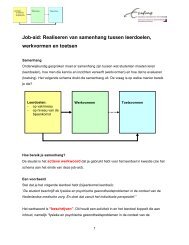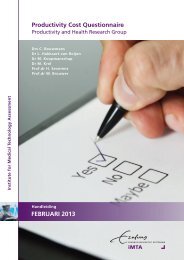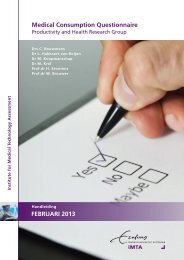Marten J. Poley - Erasmus Universiteit Rotterdam
Marten J. Poley - Erasmus Universiteit Rotterdam
Marten J. Poley - Erasmus Universiteit Rotterdam
- No tags were found...
Create successful ePaper yourself
Turn your PDF publications into a flip-book with our unique Google optimized e-Paper software.
Introduction 5relatively small discipline and that resources for cost-effectiveness research havethemselves to be prioritized.What does it take to determine the cost-effectiveness of neonatal surgery?What is needed in a cost-effectiveness study, is information on both costs andeffects. Costs and effects are preferably analyzed from a societal perspective. 4,5This implies that all costs and effects of a studied intervention should be takeninto account, irrespective of to whom they accrue. So if costs and effects occur to'significant others' than the patient, such as the parents in the case of neonatalsurgery, these should also be taken into account. Another requirement for a solidcost-effectiveness evaluation is that the follow-up period is long enough tocapture all costs and effects.Costs. As mentioned above, studies dealing with the costs of neonatal surgeryoften only focus on health care costs during the initial hospitalization. Thisobservation, for that matter, applies equally to the field of economic evaluation ingeneral. Undoubtedly, the so-called direct medical costs are often the mostimportant, comprising a large proportion of the total costs. Yet, a wide range ofother cost categories can have a strong influence on cost-effectiveness ratios.Among these other costs are direct non-healthcare costs, such as out-of-pocketexpenses and time costs, indirect healthcare costs, and indirect non-healthcarecosts. The latter two categories will now be described in some more detail, asthey are relevant for neonatal surgery.Indirect healthcare costs comprise future costs in added life-years. We maydistinguish between costs of treating clinically related diseases and costs oftreating other, unrelated diseases. For example, a patient who has recoveredfrom a life-threatening heart disease may still make costs of cardiovascularmaintenance therapy, but can also incur costs of cancer in future life-years. Muchcontroversy has surrounded the inclusion of unrelated costs. Most guidelines foreconomic evaluations published throughout the world (such as guidelines fromthe Netherlands, 20 Canada, 21,22 Australia, 23 the United Kingdom, 24 Norway, 25 andSpain 26 ) recommend that they should not be included. In the literature, there is avigorous debate between proponents 27,28 and opponents 29 of including futurecosts for unrelated diseases, and, between these two poles of thought, a campthat leaves it to the discretion of the researchers. 5,30 The debate has not onlytheoretical importance, but also important practical consequences, since includingfuture (un-)related health care costs can have a large impact on costeffectivenessratios of life-saving treatments, 31,32 which treatments in neonatalsurgery often are. The most common practice seems to be to restrict health carecosts in added life-years (if included at all) to related costs.The second cost category that is frequently ignored are indirect non-healthcarecosts. 33 These are usually restricted to productivity costs, which may be definedas costs associated with production loss and replacement caused by illness,
















